Temples in Tiruvarur
TYAGARAJA SWAMI TEMPLE
Paramasiva as Tyagaraja Swami established Tiruvarur as His royal court. Three of the shrines at the Tiruvarur temple complex are of great significance. They are the Vanmikanathar and Tyagarajar (both being forms of Paramasiva) shrines and the Kamalaamba shrine.
Vanmikanathar shrine
The primary and the most ancient of the shrines at the Tiruvarur temple complex is that of Vanmikanathar, a form of Paramasiva. Vanmikanathar is addressed in the Thevaram hymns of the 7th century CE as Aaruran or Tirumoolattaanamudaiyaar or Putridamkondaar. Today, the Tyagarajar deity is more prominent than Vanmikanathar.
Vanmikanathar is represented as a “Prithvi lingam” or an “anthill” (Prithvi meaning earth element and lingam meaning the dome-shaped representation of Paramasiva).
History
Lord Vishnu came to possess a great bow that rendered him with great might. Seized with vanity, Vishnu is said to have chased the Gods or the Devas all through the Universe. The frightened Devas fled all over the Universe and finally came to Tiruvarur and offered prayers to Paramasiva requesting him to save them from this plight.
It is said that Vishnu’s strength vanished upon his reaching Tiruvarur and he is said to have stood still, resting his head on his bow. The Devas immediately took the form of white ants, built an anthill at the end of the bow that rested on the ground, gnawed at the bow, and cut off its string. The straightening bow struck Vishnu with much force and cut off his head.
Totally dismayed at the loss of the protector of the Universe, the Devas prayed again to Shiva. Paramasiva appeared immediately and restored Vishnu to life, and upon the request of the Devas took up abode within the anthill, and is now enshrined within the anthill, as Vanmikanathar in the main shrine of the Tiruvarur temple complex.
The Aatakeswaram shrine in the Tiruvarur temple is believed to be the shrine from wherein Paramasiva appeared here in the main shrine, in the anthill. Therefore the anthill form of worship happens here.
In the main shrine dedicated to Vanmikanathar, there is an image of Bhoga Shakti (Piriyaa Vidai Amman) representing Paramasiva’s consort. This image is permanently housed in the main shrine itself and is also referred to as Padi Taandaa Pattini.
(Ref: ttp://www.templenet.com/Tamilnadu/Tiruvarur/vanmika.html)
The Tyagaraja Swami Shrine
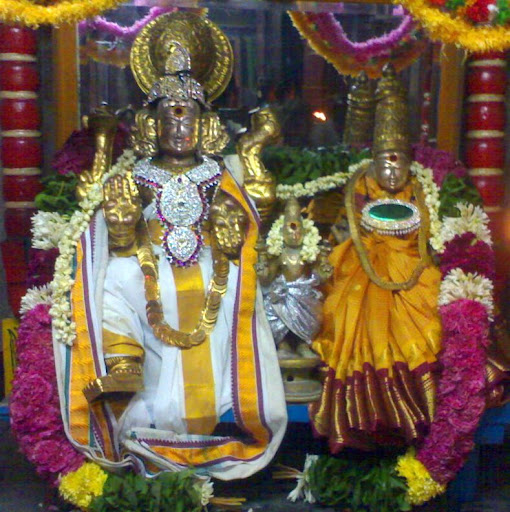
In this temple, Paramasiva sits as Tyagesha or Tyagaraja Swami in his Durbar (Royal Seat), like a king with his queen, and between them, their son Skanda (Subramanya or Muruga) dances. This setup of Paramasiva, Parvati and Skanda is called Somaskanda and is a rare sight for the devotee.
The deity of Tyagaraja at Tiruvarur is said to have been held in worship by Lord Vishnu, and later by Indra the King of the Gods and then later on by Muchukunda Chakravartia, the valorous king.
The Tyagaraja shrine at Tiruvarur is associated with the Ajapaa Natanam dance (dance without music) which is enacted every time the deity is taken out in procession.
The name Tyagaraja became associated with Somaskanda only from the 16th century onward (the earliest references to Somaskanda as Tyagaraja go back to the 12th century CE). Until that point in time, this deity was referred to as Veedhi Vitankar (meaning procession deity) in Tamil and Aaruradipati in Sanskrit.
The Nandi (sacred bull vehicle of Lord Paramasiva and therefore Tyagaraja) in front of the Tyagaraja shrine is portrayed in a standing posture, whereas it is usually sitting in other temples.
Abhishekam (oblations) rituals are performed to this deity only six times a year, and even during these occasions the entire deity is kept covered with a piece of cloth, barring the faces. On a daily basis, abhishekams are performed to an emerald Shiva lingam placed in the shrine.
This is a vital center of the Tantric Sri Chakra spiritual energy. The Sri Chakra is a 2-dimensional representative geometric form of the Cosmos carrying high energy. The Sri Chakra is etched on a plate on the Tyagaraja deity.
Neelotpalaambaal Shrine
The Neelotpalaambaal (Consort of Vanmikanathar) or Alliyankodai shrine (as referred to in the Tevaram hymns) is enshrined within the inner precincts of the temple.
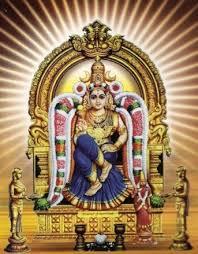
Goddess Kamalamba
the Consort of Tyagarajar Swami, is enshrined in a grand shrine in the outer prakaram (circumambulation path). The Tiruvarur Devi, Kamalambal, is the yogini. She is the tantric focus of spiritual power. Her shrine inside the temple complex of Tiruvarur faces North, the direction of Kailaasa (abode of Paramasiva), symbolizing release from the cycle of birth and death. She sits cross-legged in virginal purity. Muthuswami Dikshatar, a tantric initiate, and a genius Sanskrit composer of inordinate logical methodology and incomparable creativity recalls Sri Vidya Tantrism and powers of Kamalamba as the Yogini Deity in his exquisitely rendered compositions “Kamalamba Navaratna Kritis”. The Kamalamba shrine is regarded with great veneration and it has its own cycle of annual festivals.
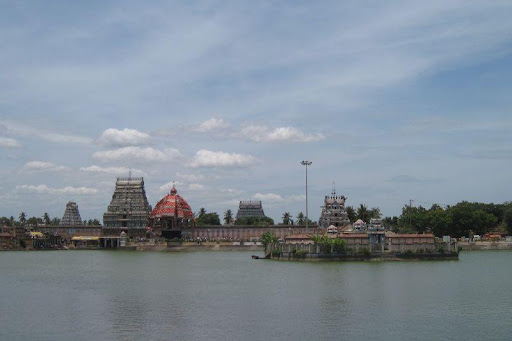
Picture: The Kamalalayam water tank
By SriniG – Own work, CC BY-SA 3.0,
https://commons.wikimedia.org/w/index.php?curid=11156173
The Kamalalaya water tank named after this tantric deity, Kamalamba, outside the western gate of the temple covers over 16 acres and is one of the largest in the country.

Grand Float festival called Theppam of the deities of the temple in the Kamalalaya water tank
Maintaining a tradition unbroken for over two thousand years, theppam, a joyous float festival in its water on a full moon January day is celebrated in this tank. A large raft with musicians singing praises of the lord is floated on the Kamalalayam.
The Tiruvarur Ther Festival
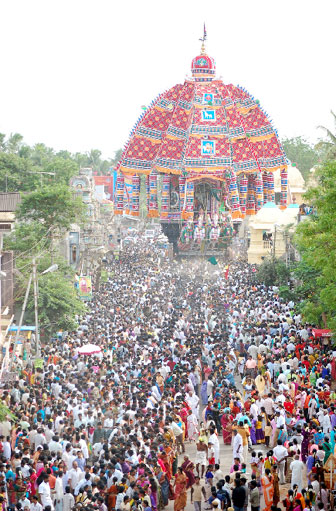
The Ther (Temple car or chariot)
https://en.wikipedia.org/wiki/Tiruvarur_Chariot_festival
The Tiruvarur Chariot festival is a historical event that still follows the same rituals and traditions associated with the Thyagaraja Swamy temple, Tiruvarur, in Tamil Nadu. The Lord Veethividangar now called as Tyagaraja Swami (a form of Paramasiva) comes out of the massive ancient temple, with His consort Kondi (a form of Devi Parvati) to bless the devotees. This chariot is the largest in Asia. It was constructed by Vishwakarma (celestial builders) community.
This is one of the very old and ancient festivals that are often mentioned in the devotional hymns of saints like Appar, Tiru Jnanasambandar and Sundarar and in many other Tamil literature. This festival is held in March-April every year and lasts more than 25 days. On the day of the chariot procession, the Utsava moorti (the Lord who comes out for procession) is beautifully decorated and brought out of the temple along with his consort and they go for the procession all day long.
The chariot is 96 feet (29 m) tall and weighs more than 300 tons with intricate wood carvings. Apart from this grand chariot there are 4 more temple cars: for the Lord’s consort, for Subramanya, Ganesha and Chandikeswara respectively. All the chariots are large, but relatively smaller than the main chariot. It requires a minimum of ten thousand people to pull the chariot around the four surrounding streets of the temple.
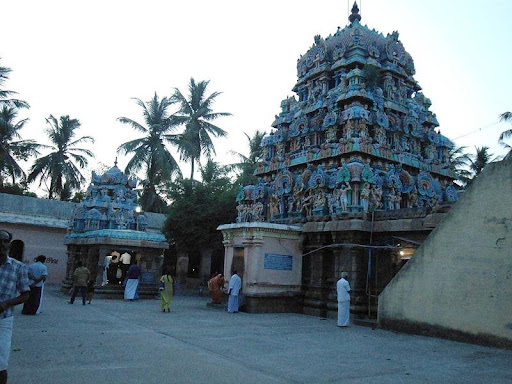
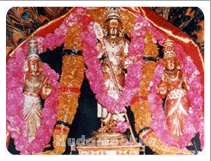
(left) Arulmighu Subramanya Swami temple in Tiruvarur
(top) The main deity of Lord Muruga with His two Divine Consorts Valli and Deivanai
https://www.kudamookku.com/aroundthecity/enkan.htm
Arulmighu Subramanya Swami temple (also called Enkan Murugan Temple) is a temple dedicated to the Hindu God Muruga situated in the village of Enkan in the Tiruvarur District of Tamil Nadu, India. It is a popular tourist destination. Enkan (also Engan) is located 13 kilometers from Tiruvarur.
History
The sculptor who sculpted the deity of Muruga in this temple is the same person who carved the deities at Sikkal and Ettukudi – other Muruga temples in this enlightenment ecosystem. Upon sculpting the deity at Sikkal, the sculptor cut his right thumb so as to ensure that he would not create anything anywhere which would surpass the beauty of the image at Sikkal. After sculpting deity idol at Ethukudi, he, however, found the idol excelling the one at Sikkal in beauty and hence blinded himself as punishment. Hence while sculpting the deity of Murugan at Engan, the sculptor had to rely on the assistance of a woman as he was blind himself. By mistake, while sculpting, he cut a finger belonging to the woman and blood began to ooze. These droplets of blood fell on his eyes curing him of his blindness. Once the sculptor realised that he could now see, he exclaimed in amazement “Engan! Engan!” meaning “My eyes” in the Tamil language.
This temple is very famous and King Raja Raja Cholan created a permanent endowment for the requirements of the daily poojas and festivals
Thaipoosam Festival
The word Thaipoosam is a combination of the name of the Vedic month, Thai (Jan-Feb), and the name of the Vedic star Poosam. This particular star is at its highest point during this festival. The festival commemorates the occasion when Parvati (Divine Consort of Paramsiva) gave Lord Muruga (Her own son) a Vel “spear” so he could vanquish the evil demon Soorapadman. The demons symbolize the negativity in us and the slaying of them is the slaying of collective negativity.
In the ongoing battle between Soorapadman and the Devas (divine beings), at one point in time, the latter were defeated several times. In despair, they approached Paramasiva and requested Him to give them an able leader under whose leadership they would gain victory over Soorapadman. Paramasiva granted their request by creating the mighty warrior, Skanda (His own son also called Muruga or Subramanya), out of His Third Eye (The energy center between the eyebrows). Skanda at once assumed leadership of the celestial forces, inspired them and defeated Soorapadman. His victory is celebrated as the Thaipoosam festival.
Kavadi Attam and Body Piercing



Devotees carry kavadi (top let), pierce their bodies (top right) and carry Pal Kodam (milk pot offerings) to show their devotion to Lord Muruga
The Kavadi Attam is the ceremonial sacrifice (a dance that helps to maintain a healthy body) and offering performed by devotees during the worship of Lord Muruga. It is performed during the festival of Thaipoosam. The Kavadi is a semicircular decorated canopy supported by a wooden rod that is carried on the shoulders to the temple.
Devotees prepare for bearing the kavadi by observing a fast for 48 days, keeping their body always clean, offering regular prayers and following a vegetarian diet before the Thaipoosam festival. Kavadi-bearers perform elaborate ceremonies at the time of assuming the Kavadi and at the time of offering it to Lord Muruga. The kavadi-bearer observes celibacy and consumes only certain types of satvic food items and continuously meditates on God. This tradition makes them physically and mentally healthy.
During this festival, many carry a Pal Kodam (pot of milk) to offer to Lord Muruga and many pierce their skin, tongue or cheeks with spears or tridents to show their devotion and respect to Lord Muruga.
Mahamariamman temple
History
In a street named Valangaiman Varadharajanpettai, about 200 years ago there lived a farmer named Kathagounder. He and his wife Govindammal were both devotees of God. His wife prepared eatables and sold them for a living in the nearby villages especially Pungancheri South East of Valangaiman.
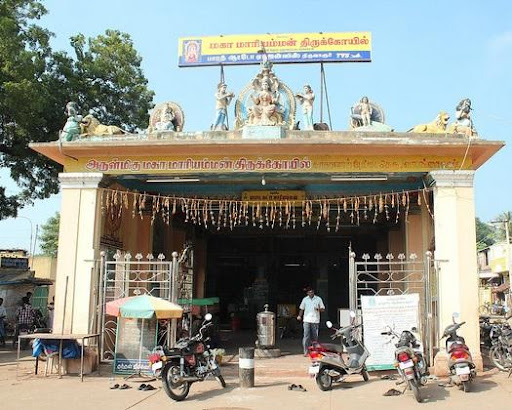
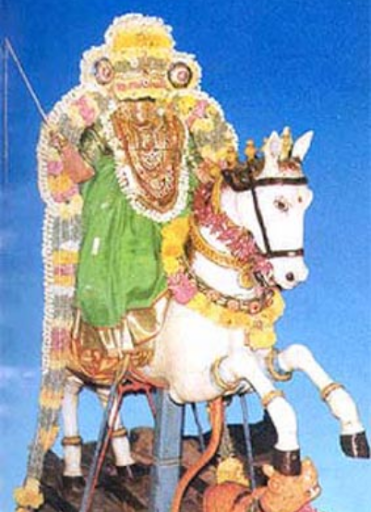
Mahamariamman temple and the deity are seen here
One Friday, Govindammal went to Pungancheri for her business. She sold her eatables and got a lot of money and paddy in return for it. She went to a water tank to have a bath, and there she saw a brahmin (community) couple with their child going towards the Adaikkalam Katha Ayyanar Temple. Govindammal suddenly heard the cry of a child from the side of the Ayyanar temple. She hurried to the spot and found a girl child was crying there. She called the neighbours and the people on the streets and looking for the child’s parents but there was nobody.
Govindammal took the crying child and the child immediately started laughing. The people of the street were attracted by beauty of the child and wanted to bring up the child themselves.
Finally the people decided that the leader of the street (Nattamai) should bring up the child. Govindammal felt sorry that she did not get the child. She returned to her house and for three days she didn’t go to Pungancheri for sales.
In Pungancheri, all of a sudden, fowls, sheep and cattle died and many people suffered with smallpox. The child from the Ayyanar temple was also infected with smallpox. There was confusion everywhere. A furious man said that the child should be given to Govindammal and said that only then the village would become well.
Immediately they called Govindammal and gave the child to her. Govindammal got the child, named her as ‘Sithala’ and began to bring her up. But on the 3rd day, due to acute smallpox, the child passed away. Govindammal and her husband with sorrowful hearts performed the funeral at the back of their house.
People bathing in the Kudamurutti river, would cross the backyard of Govindammal’s house and word spread that it was Mariamman (a name for the Universal Cosmic Mother) who came to the house of Govindammal in the form of the child, and they immediately built a Sithala Devi Mahamariamman temple there and considered the Goddess as Mother Parasakthi – the Universal Cosmic Mother. This is the historical background of the Valangaiman Mahamariamman temple.
In India this is the only separate temple for Goddess Sithala Devi called as “Padaikatti Mariamman” who protected the people from smallpox and many other diseases. This Goddess Padaikatti Mariamman has a supreme power that she radiates to her Devotees.
Devotees here follow a strange custom of prayer commitment by doing a ritual with Paadai – a structure generally used for carrying a dead body.
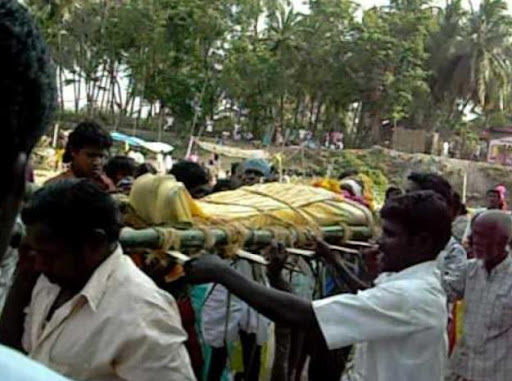
The Paadai festival is celebrated in the Vedic month of Panguni (March-April). Sick people pray to this Devi that they would offer the Paadai Kavadi to her after recovery from illness. The patient after recovery will then lie on this Paadai as a dead person accompanied by the son and wife. The patient will be brought to the temple. The priest would sprinkle the sacred water from the temple on the body. And the person would wake up as if from death by the grace of the Devi. The belief is that She would not let her devotee die.
Every year in the days of this month, the Paadaikatti festival attracts lakhs of people from all over the country and they get a turning point in their life. During the Vedic months of Avani (Aug-Sep) and Panguni (Sep-Oct) 10-day festivals are celebrated in this temple for the Devi.
Maha Saraswati Amman temple
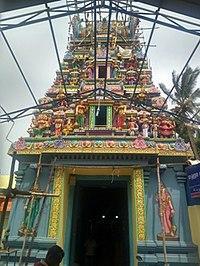
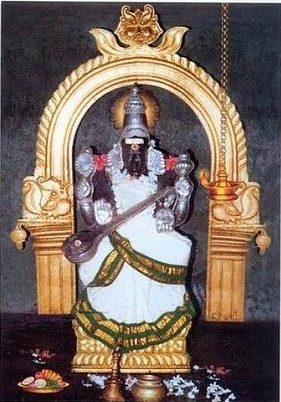
Maha Saraswati Amman temple and the deity of Maha Saraswati inside the temple
Goddess Saraswati is the Goddess of learning. Koothanur Maha Saraswathi Temple is located in the town of Koothanur in the Tiruvarur district of Tamil Nadu, India dedicated to Goddess Saraswati. Here the Navaratri festival is celebrated in a grand fashion.
Navarati Festival
One of the most sacred and divine nights of worship of the primordial Mother Adi Shakti (Universal Cosmic Mother) is the Navaratri or “nine nights”. The Goddess is worshipped in her multiple forms and grants ultimate blessings to her devotees destroying the negativity in them during this period. This festival celebrates the victory of good over evil and wakes up one from the deep slumber of ignorance, clearing all the surrounding negative energies, purifying the mind and adopting a positive attitude or virtues in life. This transformation helps one gain spiritual knowledge and achieve enlightenment.
The nine nights invoke the various powerful forms of Adi Shakti namely Durga, Lakshmi and Saraswati who stand for power, wealth and knowledge respectively. The ninth day is dedicated to Goddess Saraswati. A special Saraswati puja (ritualistic worship) is performed to her this day. All one’s books of learning, equipment and tools of usage are brought out and offered to Goddess Saraswati on this day for blessings. In the northern parts of India, Navaratri concludes with Dussehra on the tenth day and in southern parts with Vijaya Dasami on this day, celebrating the victory of Adi Shakti over evil.
Widespread homas (ritualistic fire offering) and pujas (ritualistic offering) to Adi Shakti are performed during this period.
Arulmigu Somanatha Swamy Thiru Koil
The deity Arulmigu Somanatha Swamy has all along been worshipped to end mental agonies and mental stress of devotees who seek His blessings at this temple. This temple is located in South India in the state of Tamilnadu close to the famous temple of Thyagaraja Swamy temple at Tiruvarur. Somanatha Swamy’s consort in this temple is Devi Jnanasiddhi Yogambigai.
In ancient times Prajapati Daksha had offered his 27 daughters [present nakshatras] to lord Chandran. Chandran due to his haughtiness coming from His handsomeness showed favoritism to only one of his wives ‘Rohini’ neglecting the others. Prajapati Daksha was agonized by this injustice meted to his other daughters and cursed Chandran As a result of this, Chandran, the Moon God’s radiance diminished. To release Him of the curse he decided that Sadashiva was his only resort. He came to Bhuloka [ Earth] and started penance under a Bilva tree. Inspired through the penance he poured life energy – ‘Pranapratishta’ – into a Chandrakantha stone which he worshipped thereon as Shiva. Pleased by His devotion Sadashiva and Consort Devi appeared and blessed Him. To release Chandran of his curse, Lord Sadashiva himself created a Tirtha there, which is present ‘Chandrapushkarini’. Chandran, in turn, requested Lord Sadashiva and Devi to be the presiding deities in the sthalam relieving the devotees who come to worship Them from mental agonies and confusion. Lord Sadashiva accepted his request. Devi Jnanasiddhi Yogambigai removes ignorance and provides wisdom to those who worship her. To date, the devotees coming here are relieved of their mental agony and experience higher spiritual knowledge. This place is also known for devotional songs being sung to Lord Sadashiva and Devi by Shaiva samanar. There is evidence that many times Vanthondar known as Tambiran tholar Sundaramurthy peruman has resided here and made His presence felt. Many hundreds of years ago Dakshinamurthy Swamy resided here for fourteen years and did penance. History reveals that Devi Jnanasiddhi Yogambigai appeared before him and blessed him with enlightenment.
The responsibility of the activities of this sthalam is now with His Divine Holiness Paramahamsa Nithyananda, Mahamandaleshwar of the Mahanirvani Akhada.
